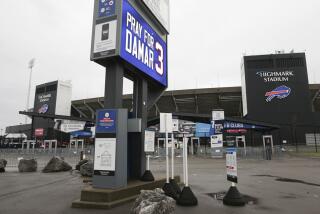Problem Isn’t Drop in Bucket
- Share via
If you want to stir emotions around the NFL, just talk about fumbles.
Quarterbacks fear them, linebackers love them and offensive coaches loathe them.
For running backs, it’s even more personal.
Because their main job is carrying the ball, running backs understand that losing control of it can have more impact on their playing time than yards gained.
A fumble by a running back usually happens like this: He gets a handoff and runs through a hole made by his offensive line. Before he can get into the secondary, he is hit by a linebacker but not stopped. Hoping to gain additional yardage, the back extends himself, losing his concentration on holding the ball.
The result? Fumble.
And it’s an equal-opportunity problem. Hall of Fame running back Gale Sayers once led the league in fumbles lost on kickoff returns. Eric Dickerson left the football on the ground lots more than his coaches would have liked.
Fumbles almost never are good, but some are worse than others. Consider Earnest Byner:
In the AFC championship game in January 1988, Byner, playing running back for the Cleveland Browns, was about to score the winning touchdown when he fumbled at Denver’s three-yard line seconds before the end of regulation play. Cleveland fans will always remember Byner not for his great all-around game against the Broncos that day but for his untimely fumble that all but ended the Browns’ season and helped send Denver, a 38-33 winner, to the Super Bowl.
Among today’s running backs, Baltimore’s Jamal Lewis, Green Bay’s Ahman Green, Miami’s Ricky Williams, the New York Giants’ Tiki Barber and even Tennessee’s aging Eddie George have proved that they match up with anyone who has played in the league.
But despite their speed, strength, durability, game-breaking athleticism and accomplishments, each is known for his tendency to fumble.
Thanks to his record-breaking 295-yard performance against Cleveland, Lewis has led the NFL in rushing for much of the season. But he also ranks among the league leaders in fumbles, and his miscues have cost the Ravens.
In an overtime loss to Miami, Lewis’ fumble in the extra period was recovered by the Dolphins, who won four plays later on a field goal. In a Raven loss a week earlier at St. Louis, Lewis fumbled twice, once inside the Rams’ 20-yard line, costing Baltimore at least three points in a tight game.
Green, the NFC’s leading rusher, is having a record-breaking season for the Packers. He has rushed for at least 100 yards in eight games and is on pace to establish a franchise record for yards rushing in a season.
Still, he hasn’t been able to shake his reputation as a fumbler.
Seattle Coach Mike Holmgren traded him to the Packers after Green had fumbled once as a rookie in 1998 and twice in 1999. Green then became the Packers’ main ballcarrier in 2000 and fumbled six times. The next season, Green fumbled five times and last season, six times.
In 12 games this season, Green has had seven fumbles, including five lost. And like Lewis’, Green’s drops have hurt his team.
In the Packers’ 40-34 loss to Kansas City in October, Green fumbled one play after Green Bay had blocked a potential winning field goal attempt in overtime. On the next play, Kansas City got the winning touchdown on a 51-yard pass play from Trent Green to Eddie Kennison.
Green lost two fumbles in the Packers’ 17-14 loss to Philadelphia in early November. He rushed for a career-high 192 yards and scored two touchdowns, but his fourth-quarter fumble cost the Packers a victory.
In 58 games with the Packers, Green has fumbled 22 times, opponents recovering 16 of them.
According to Stats Inc., Green has fumbled 25 times since he came into the NFL in 1998. That ranks him fourth among running backs from 1998 to the present, behind Barber (39 fumbles), Williams (32) and George (26).
But not all of today’s backs are fumblers. The New York Jets’ Curtis Martin has been around for years and has fumbled only 13 times since 1998. The Kansas City Chiefs’ Priest Holmes has dropped the ball only 11 times in his seven-year career.
The NFL can only hope that young players of tomorrow take note of players such as Martin and Holmes, who understand that taking care of the ball is as important as gaining yards.
More to Read
Go beyond the scoreboard
Get the latest on L.A.'s teams in the daily Sports Report newsletter.
You may occasionally receive promotional content from the Los Angeles Times.










